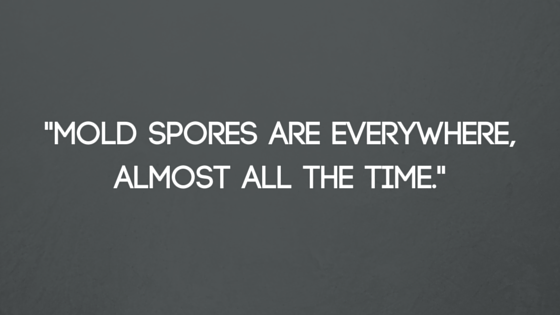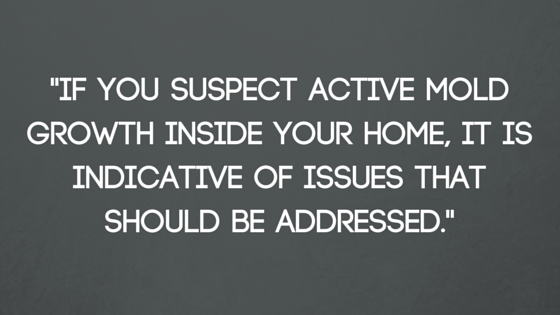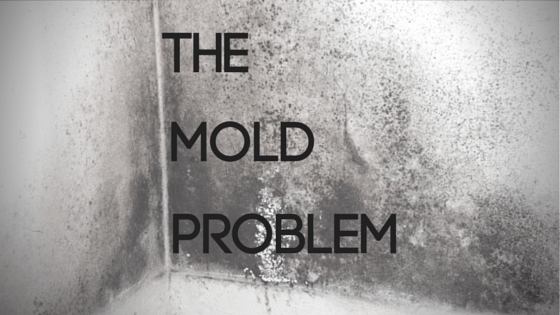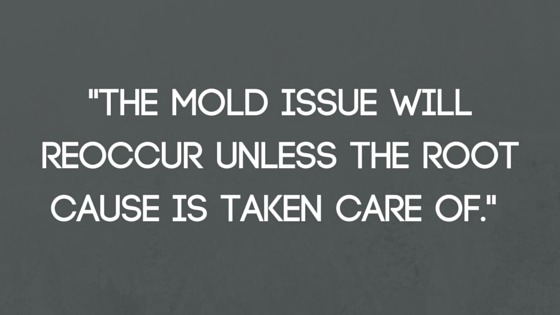If you read our last post, you know that formaldehyde is abundant in our natural environments, and sometimes our homes. The story is much the same with mold.
Mold spores are everywhere, almost all the time. It is not possible to build a standard residential home that will keep outside mold spores from entering. What can be controlled are the requirements that mold has for growth and reproduction; natural mold spores will only become indoor mold under the right conditions.

There are a handful of tell-tale signs of potential mold growth…
- A musty smell
- Visible mold growth
- A water intrusion into the home
- Uncontrolled humidity
…and it requires three things to live.
- Adequate moisture, including water intrusion, condensation, and even humidity hovering around or above the upper levels of ASHRAE human comfort levels (>60%)
- Adequate temperature, generally within the comfort range of humans
- Food, including any source of carbon. A thin layer of dust on a wall is enough to sustain mold although building products like wood and drywall are excellent food sources
If you suspect active mold growth inside your home, it is indicative of issues that should be addressed. Most mold is benign to humans, but immunocompromised people and those with allergies may experience adverse health effects due to mold growth in the home.

Water intrusions into the home will almost always result in mold. The culprit could be a roof leak or a flooding basement, or a myriad of smaller issues. The key to preventing mold from becoming a secondary issue of water intrusion is to dry the area thoroughly within 48 hours. Most importantly, it is essential to fix the root issue of the water intrusion.
In most cases, indoor air quality (IAQ) professionals dealing with mold sampling will give homeowners the same advice: “Stop the water intrusion, dry and clean non-porous surfaces thoroughly, discard porous surfaces that show signs of mold growth or water damage, and control indoor humidity levels.”
All perfectly fine advice, but if you can see mold in the home, you do not need a professional to perform sampling that will determine the concentration of spores or genus/species identification. Skip right to the recommendations which are fairly standard, and while you’re at it, skip the home mold testing kit. They are generally not worth the cost, unless it’s to satisfy curiosity. Instead, take any money that would be spent on a testing kit and direct it towards correcting the root problem.
It is common for small areas of mold to grow in the home. You may notice it along interior window sills because of the temperature differential condensation or in poorly-ventilated bathrooms due to high humidity. Minor mold growth in damp basements is also common. In these cases, the most effective action is clean affected areas and increase ventilation (bathroom) or dehumidify (basement). Surfaces may also be coated with specialty paints that reduce mold growth.
In more severe cases, it is important to remember that the mold issue will reoccur unless the root cause is taken care of. A basement that floods in the spring or a leaky roof must be corrected to permanently address the guaranteed mold issues that come along with it.
If there is no obvious source of water intrusion, the first place to investigate is the plumbing system. Small plumbing leaks inside walls can go unnoticed for a long time with little indication beyond the annoyance of an elevated water bill.
Quick Tip: Leaking toilet wax rings are a common culprit because the water source is periodic and of low enough quantity that it may saturate building products without producing free water in the home.
Once the water intrusion has been addressed, there are firms who will handle mold remediation and cleaning. Alternatively, residents may undertake the cleaning process themselves. The basic rules include:
- Porous surfaces that remained wet for more than 48 hours (carpet, drywall, ceiling tiles, etc.) should be removed and thrown out. In some cases, steam cleaning the carpet can suffice, but it depends on how long the carpet was wet and whether or not mold is visible on the surface.
- Hard surfaces such as concrete floors and walls can be cleaned. A commercially available biocide or other cleaning product can be used.
- Some porous building materials can be cleaned (for example, wood and even drywall) if the mold is on the surface only. These materials may benefit from a coat of specialty paint after cleaning. Quick Tip: If structural wood has become soft, it should be inspected by a licensed contractor to address potential issues.
- Ensure that the affected areas are completely dried before replacing any building materials.
- The affected area (and whole home, if possible) should be thoroughly ventilated after the cleaning process.
- Determine the cubic footage of the home (length x width x height). Ventilation should be equivalent to four complete air exchanges of the home.
- Close all but one or two windows in the home and put a large fan in a window nearest the affected area. Quick Tip: A rental fan will be rated in Cubic Feet per Minute. A simple calculation will tell you how long the fan has to run to exchange the air in the home four times.
- Do not leave a window near the exhaust open as this will likely lead to the intake of contaminated air, and if possible, the air intake should be as far from the exhaust fan as possible.
- Affected areas may benefit from maintaining low humidity through dehumidification for some time after the cleaning process.
If there are concerns about the successful completion of remediation following ventilation, hire a professional to perform non-viable spore trap sampling/analysis in the home. If you end up having to take those measures, it is advisable to include third-party air sampling after cleaning to confirm that the project was completed.


